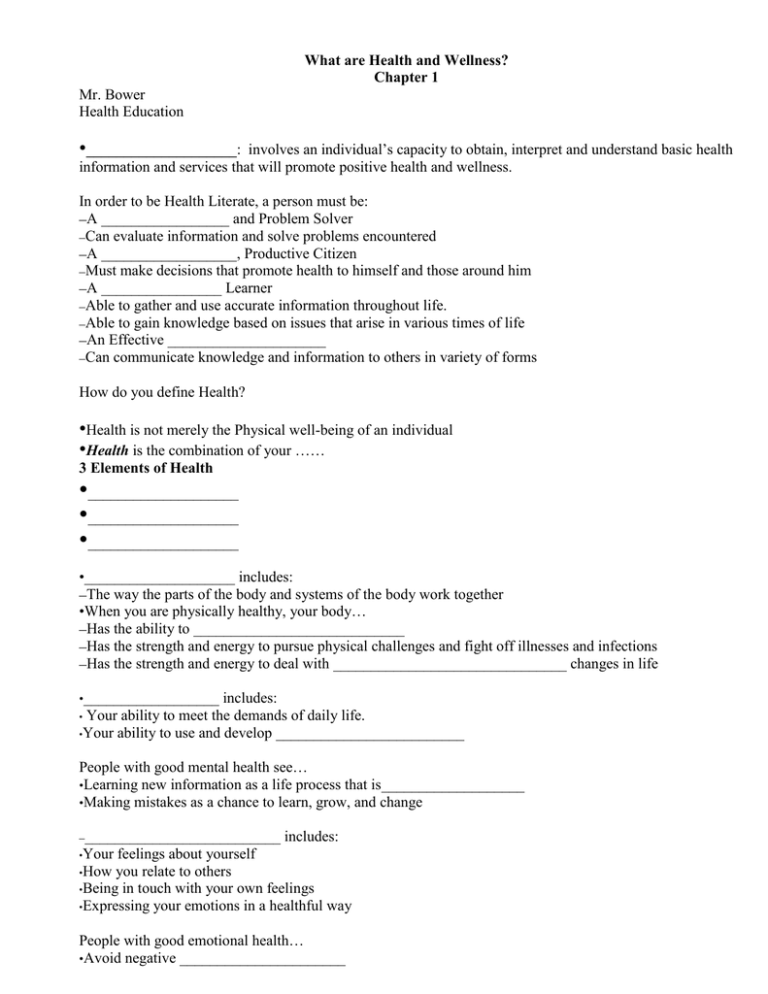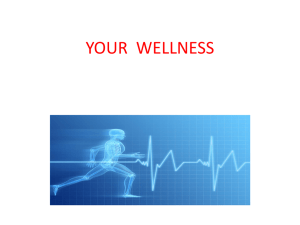•
advertisement

What are Health and Wellness? Chapter 1 Mr. Bower Health Education •____________________: involves an individual’s capacity to obtain, interpret and understand basic health information and services that will promote positive health and wellness. In order to be Health Literate, a person must be: –A _________________ and Problem Solver –Can evaluate information and solve problems encountered –A __________________, Productive Citizen –Must make decisions that promote health to himself and those around him –A ________________ Learner –Able to gather and use accurate information throughout life. –Able to gain knowledge based on issues that arise in various times of life –An Effective _____________________ –Can communicate knowledge and information to others in variety of forms How do you define Health? •Health is not merely the Physical well-being of an individual •Health is the combination of your …… 3 Elements of Health •____________________ •____________________ •____________________ •____________________ includes: –The way the parts of the body and systems of the body work together •When you are physically healthy, your body… –Has the ability to ____________________________ –Has the strength and energy to pursue physical challenges and fight off illnesses and infections –Has the strength and energy to deal with _______________________________ changes in life •__________________ includes: Your ability to meet the demands of daily life. •Your ability to use and develop _________________________ • People with good mental health see… •Learning new information as a life process that is___________________ •Making mistakes as a chance to learn, grow, and change –__________________________ includes: •Your feelings about yourself you relate to others •Being in touch with your own feelings •Expressing your emotions in a healthful way •How People with good emotional health… •Avoid negative ______________________ •Consider all options and situations, then rationally expresses his/her emotions in response to the situation __________________ •Involves the way you get along with others. •Also involves: –Your ability to make and ______________________friends –Your ability to cooperate and communication with others around you. –It involves a constant respect and sense of responsibility for self and others. The Health Continuum •Your health is dynamic (always changing) •Your health is always changing its place on the continuum •From day to day (year to year), you experience different levels of total health •WELLNESS – __________________________________________________ •A person with a balanced life is said to have a high degree of wellness, or total health. •It comes from a way of living each day that includes making decisions and practicing behaviors that are based on sound health knowledge and healthful attitudes. •Achieving wellness is an ongoing, lifelong commitment to physical, mental/emotional, and social health. Our Goal Promoting Your Health •There are 3 ways to promote your health and wellness –(+) _________________ –(+) Attitudes Toward Health –____________________ (+) Lifestyle Factors •Lifestyle factors: are personal behaviors and habits related to the way that a person lives, that helps to determine a their health •Seven (+) Lifestyle factors –Sleep __________ hours per night –Eat nutritious foods from each of the food groups –Refrain from smoking, tobacco products and those who do use those products –Eat breakfast daily –Do __________ minutes of non-stop physical activity at least _____ times per week –Do not use ______________ –Maintain recommended weight HOW MANY OF THESE LIFESTYLE FACTORS DO YOU FOLLOW? (+) Health Attitudes •It is not enough to just KNOW what to do to stay healthy. •You must BELIEVE that there is some benefit to good health habits and problems for poor health habits. •Studies have shown that people with (+) attitudes are less likely to suffer injury and illness than those who have (-) attitudes (STRESS) •Prevention: practicing healthy habits to keep a person well and free from disease and other ailments •Preventing injury and illness is the best way to promote health •Examples: –Wear seatbelt –Wear helmets –Apply sunscreen –Avoid dangerous situations/areas –Perform (+) lifestyle factors Three categories of risk factors: 1. 2. 3. Heredity risk factors – to some extent, a person’s health is determined at the time he is born! Inherited risk factors such as… •High blood pressure •Breast cancer •Heart disease Can you do anything about inherited risk factors? •Environmental risk factors the surroundings in which one lives, both physical and social. Physical environment – includes both your ____________________ environment. Things such as….. •Air •___________ •Sun (radiation) •Loud noises •Poisonous wastes •Smoke filled room •Social Environment – the _____________________________ around with…your family, friends, classmates. •At your age, your friends have a great influence on your level of wellness. WHY??? •Behavioral Risk Factors – are the day to day decisions that you make. •They are often far more important to your health than both heredity and environmental risk factors. •You alone decide which behavioral risk factors you will face such as… •Drugs, tobacco, foods, keeping anger and strong feelings bottled up inside, not taking time to relax •There are many behavior risks that are worth taking! What would be some of your choices? Taking responsibility for your health •You are at the age where you have more control over your life than at any earlier age. Three most common causes of teenage death are not due to illness. Do you know the top three? (Hint: all three are linked to behavioral risk factors.) Three most common causes of teenage death are: –1. –2. –3. What risk behavior is common to all three? _______________________________ •INFORMATION GATHERED FOR OTHER AGE GROUPS ALSO SHOW BEHAVIOR RISK FACTORS TO BE AT THE ROOT OF MANY OF THE COUNTRY’S HEALTH PROBLEMS. •The practice of __________________, or the practice of healthy behaviors can help keep a person free of disease and other health problems How can you make changes for your health? __________________ – you must be aware of potential health problems such as health concerns that run in your family’s history. Or, recognize unhealthy signs and see a doctor for treatment ______________ – once you become aware of health problems, learn some of the facts about it! •_________________ – even with awareness and knowledge, it is not always easy to decide on the best course of action. Consider your values – the standards and beliefs that are important to you. Apply the skill by practicing it. Make it a habit, such as daily exercise, healthy food choices, healthy ways to release anger… Decisions Making Process Objectives •TSWBAT –Understand vocabulary connected with the decision making and goal setting life skills –Make appropriate healthful decisions by using the Decision Making model –Show an understanding of the types of goals one can make for themselves Decision Making and Goal Setting •When you make decisions or set goals, you are experiencing power over how healthy, happy and productive you can be. •Making responsible decisions and setting MEANINGFUL goals are important skills that can promote individual, family and community health. Decision Making Skills: –steps that enable you to make a healthful decision. These steps are designed to protect your rights and health while respecting the rights and health of others around you. Decision Making Skill •_______________ the problem •________________ the alternatives •________________ the consequences __________________ your values •_________________ and act on decision •__________________ the result DECIDE •DEFINE THE PROBLEM: –What are you trying to DECIDE? –State the issue clearly –Is it important and complex enough? •EXPLORE THE ALTERNATIVES: –List all of the possible choices you could make to solve the problem –“Doing nothing” can be an alternative to explore –Make sure choices are realistic •CONSIDER THE CONSEQUENCES: Use the word HELP to guide your choices: –H (Healthful)- What health risks will this option present, if any? –E (Ethical)- Does this choice reflect what you and your family believe is right? –L (Legal)- Does this option violate any local, state or federal laws? –P (Parent Approval)- Would your parents or guardians approve of this choice? •IDENTIFY YOUR VALUES: –The things you believe in strongly affect how you live your life –May or may not influence decisions –Overlooking values may lead to uncomfortable feelings about decision later –Consider long term goals as well as beliefs of family, religion, and community –Which choice is most in line with your values? •DECIDE AND ACT: –Compare the alternatives –Choose the alternative that is best for you –There may be more than one “right” choice –Act on the decision by breaking it down into smaller steps and setting realistic deadlines for each step –Follow through with your plan –Your decision should not be Impulsive! •EVALUATE THE RESULTS: –After decision has been put into effect take time to review it, how did it work out? –How has it affected your life? –How has it affected others? –What did you learn? –If you could do it over again, would you do it differently?



